Kent Institute: Leadership for Managers Reflective Journal Analysis
VerifiedAdded on 2022/11/14
|11
|2686
|303
Journal and Reflective Writing
AI Summary
This assignment presents a student's reflective journal entry focusing on their experience as a project leader in a multinational corporation. The journal details the student's application of leadership styles, initially employing an autocratic approach, and analyzes the resulting challenges, including demotivation and lower productivity within the team. The reflection explores key learnings such as effective communication, new idea generation, and relationship building, as well as the importance of motivational factors and time management. Furthermore, the student examines various leadership styles, including democratic, transformational, and laissez-faire, and reflects on how they would adapt their approach in future situations, advocating for a situational leadership style and the implementation of motivational strategies to enhance team performance. The journal concludes with a summary of the experience and proposed changes for future leadership endeavors.
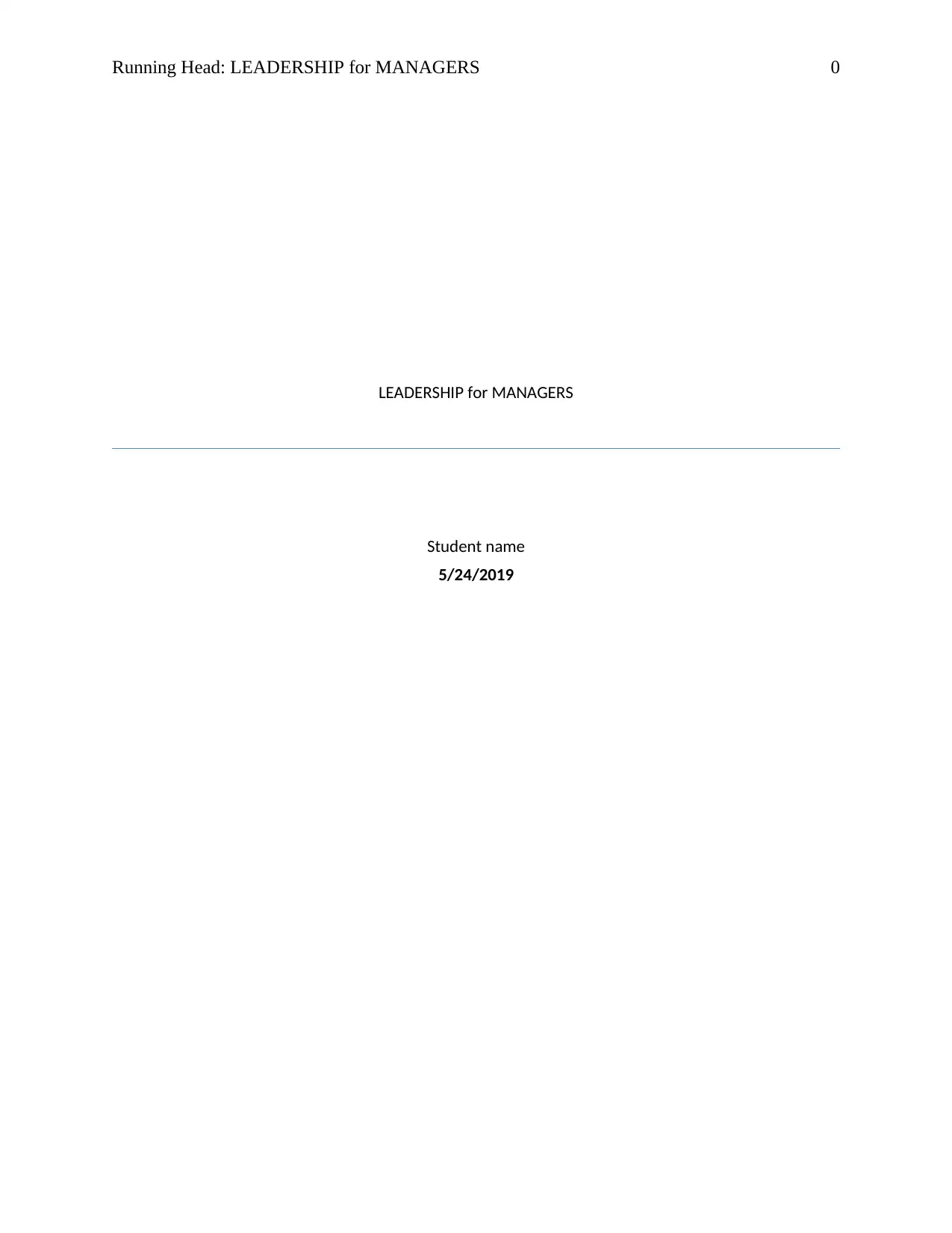
Running Head: LEADERSHIP for MANAGERS 0
LEADERSHIP for MANAGERS
Student name
5/24/2019
LEADERSHIP for MANAGERS
Student name
5/24/2019
Paraphrase This Document
Need a fresh take? Get an instant paraphrase of this document with our AI Paraphraser
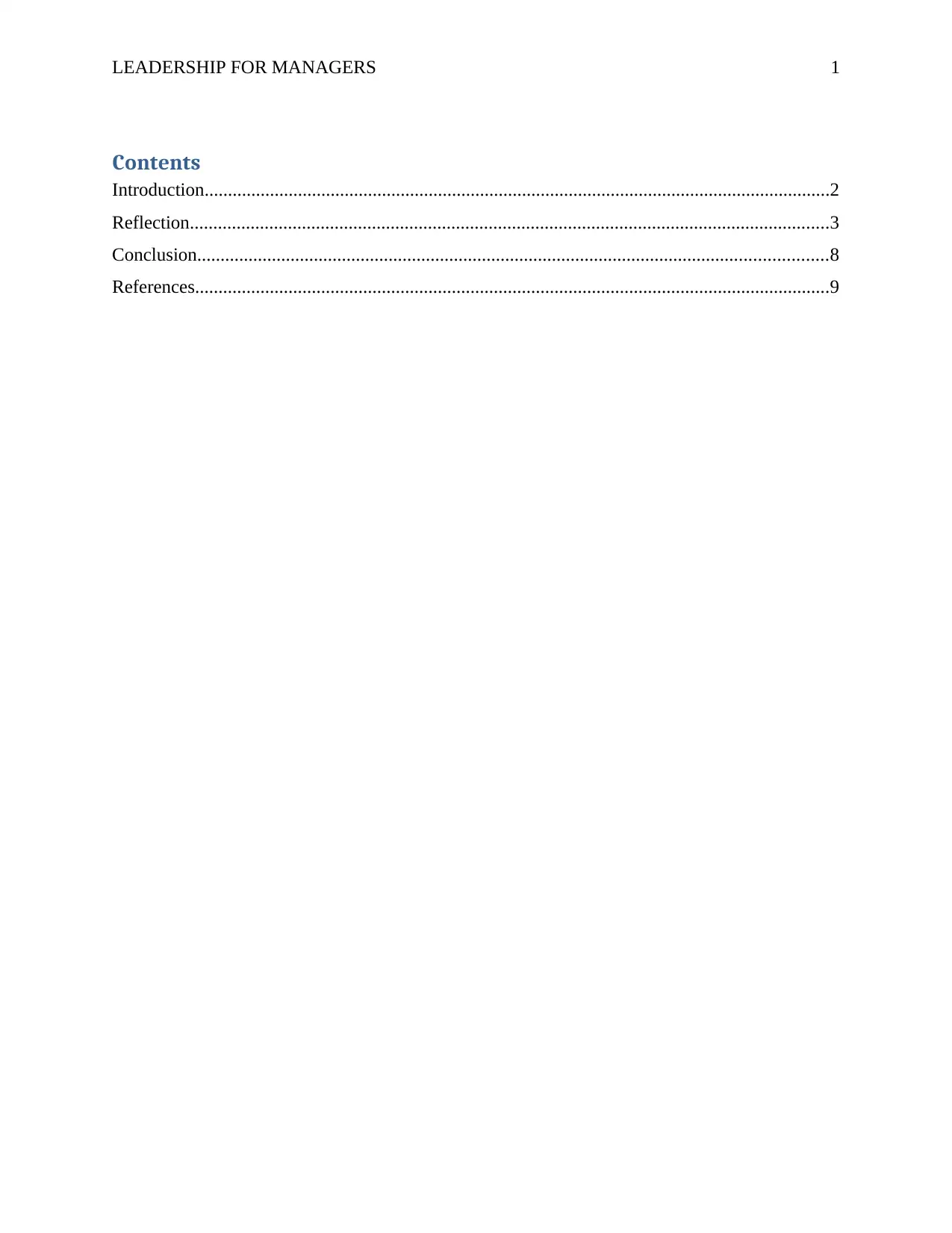
LEADERSHIP FOR MANAGERS 1
Contents
Introduction......................................................................................................................................2
Reflection.........................................................................................................................................3
Conclusion.......................................................................................................................................8
References........................................................................................................................................9
Contents
Introduction......................................................................................................................................2
Reflection.........................................................................................................................................3
Conclusion.......................................................................................................................................8
References........................................................................................................................................9
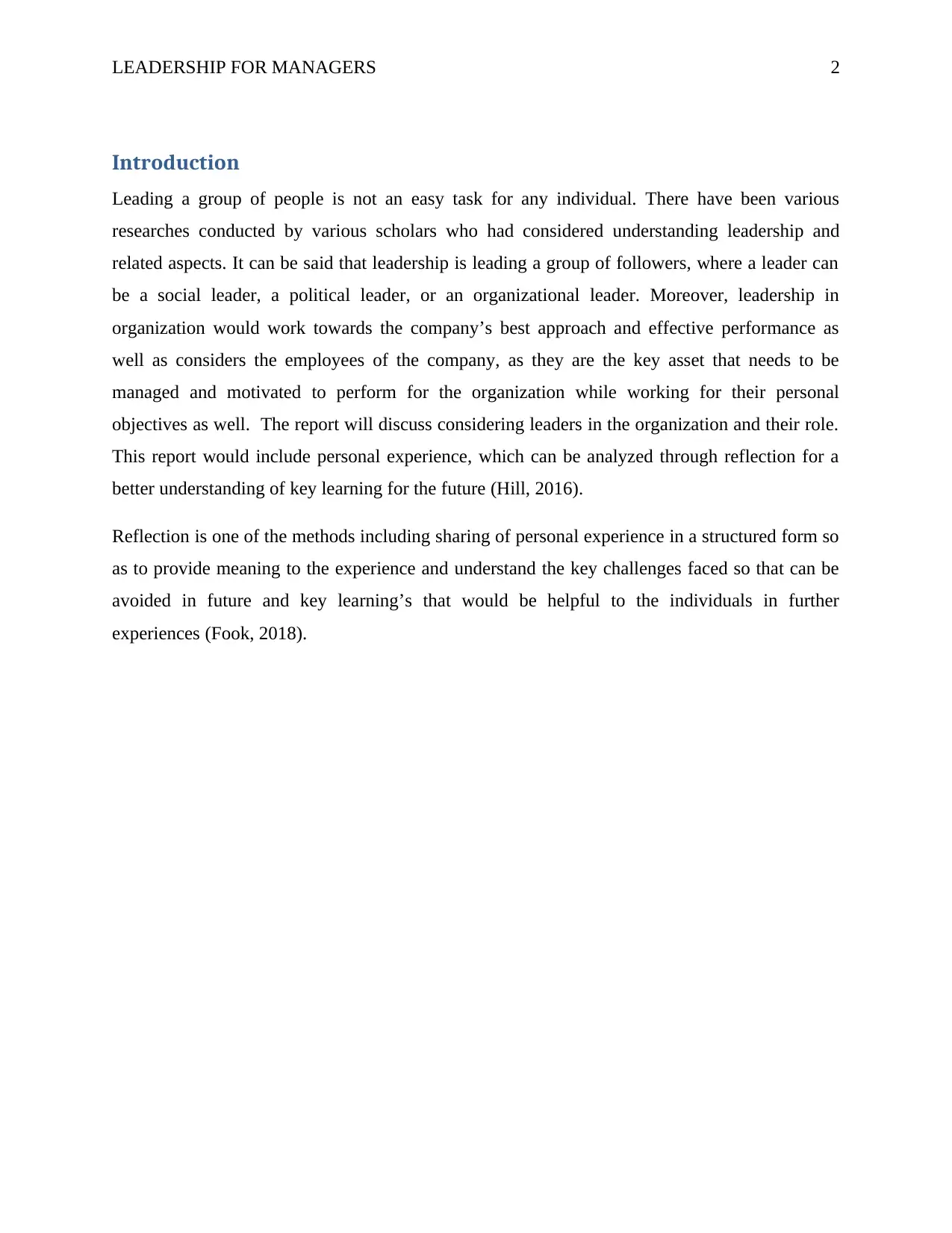
LEADERSHIP FOR MANAGERS 2
Introduction
Leading a group of people is not an easy task for any individual. There have been various
researches conducted by various scholars who had considered understanding leadership and
related aspects. It can be said that leadership is leading a group of followers, where a leader can
be a social leader, a political leader, or an organizational leader. Moreover, leadership in
organization would work towards the company’s best approach and effective performance as
well as considers the employees of the company, as they are the key asset that needs to be
managed and motivated to perform for the organization while working for their personal
objectives as well. The report will discuss considering leaders in the organization and their role.
This report would include personal experience, which can be analyzed through reflection for a
better understanding of key learning for the future (Hill, 2016).
Reflection is one of the methods including sharing of personal experience in a structured form so
as to provide meaning to the experience and understand the key challenges faced so that can be
avoided in future and key learning’s that would be helpful to the individuals in further
experiences (Fook, 2018).
Introduction
Leading a group of people is not an easy task for any individual. There have been various
researches conducted by various scholars who had considered understanding leadership and
related aspects. It can be said that leadership is leading a group of followers, where a leader can
be a social leader, a political leader, or an organizational leader. Moreover, leadership in
organization would work towards the company’s best approach and effective performance as
well as considers the employees of the company, as they are the key asset that needs to be
managed and motivated to perform for the organization while working for their personal
objectives as well. The report will discuss considering leaders in the organization and their role.
This report would include personal experience, which can be analyzed through reflection for a
better understanding of key learning for the future (Hill, 2016).
Reflection is one of the methods including sharing of personal experience in a structured form so
as to provide meaning to the experience and understand the key challenges faced so that can be
avoided in future and key learning’s that would be helpful to the individuals in further
experiences (Fook, 2018).
⊘ This is a preview!⊘
Do you want full access?
Subscribe today to unlock all pages.

Trusted by 1+ million students worldwide
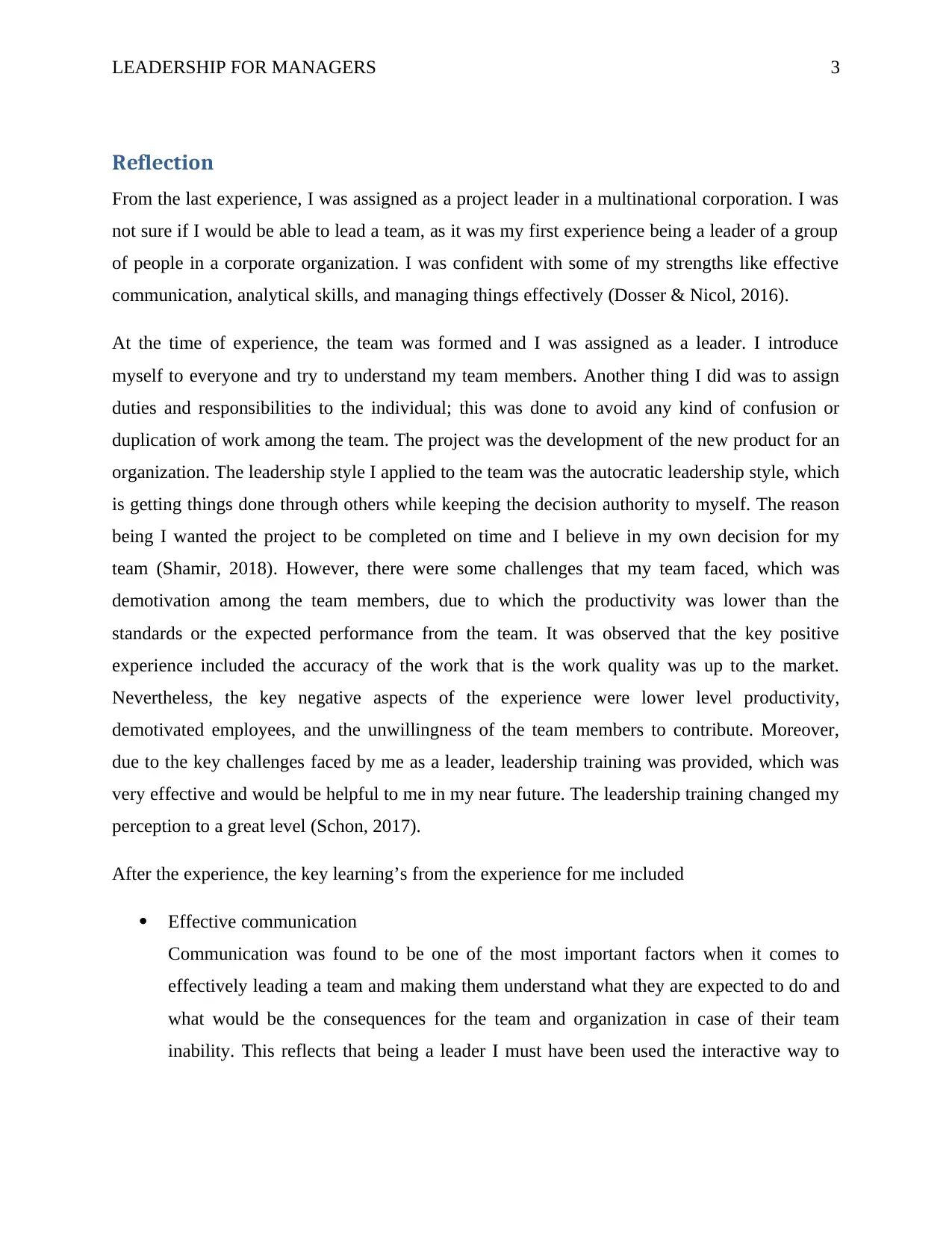
LEADERSHIP FOR MANAGERS 3
Reflection
From the last experience, I was assigned as a project leader in a multinational corporation. I was
not sure if I would be able to lead a team, as it was my first experience being a leader of a group
of people in a corporate organization. I was confident with some of my strengths like effective
communication, analytical skills, and managing things effectively (Dosser & Nicol, 2016).
At the time of experience, the team was formed and I was assigned as a leader. I introduce
myself to everyone and try to understand my team members. Another thing I did was to assign
duties and responsibilities to the individual; this was done to avoid any kind of confusion or
duplication of work among the team. The project was the development of the new product for an
organization. The leadership style I applied to the team was the autocratic leadership style, which
is getting things done through others while keeping the decision authority to myself. The reason
being I wanted the project to be completed on time and I believe in my own decision for my
team (Shamir, 2018). However, there were some challenges that my team faced, which was
demotivation among the team members, due to which the productivity was lower than the
standards or the expected performance from the team. It was observed that the key positive
experience included the accuracy of the work that is the work quality was up to the market.
Nevertheless, the key negative aspects of the experience were lower level productivity,
demotivated employees, and the unwillingness of the team members to contribute. Moreover,
due to the key challenges faced by me as a leader, leadership training was provided, which was
very effective and would be helpful to me in my near future. The leadership training changed my
perception to a great level (Schon, 2017).
After the experience, the key learning’s from the experience for me included
Effective communication
Communication was found to be one of the most important factors when it comes to
effectively leading a team and making them understand what they are expected to do and
what would be the consequences for the team and organization in case of their team
inability. This reflects that being a leader I must have been used the interactive way to
Reflection
From the last experience, I was assigned as a project leader in a multinational corporation. I was
not sure if I would be able to lead a team, as it was my first experience being a leader of a group
of people in a corporate organization. I was confident with some of my strengths like effective
communication, analytical skills, and managing things effectively (Dosser & Nicol, 2016).
At the time of experience, the team was formed and I was assigned as a leader. I introduce
myself to everyone and try to understand my team members. Another thing I did was to assign
duties and responsibilities to the individual; this was done to avoid any kind of confusion or
duplication of work among the team. The project was the development of the new product for an
organization. The leadership style I applied to the team was the autocratic leadership style, which
is getting things done through others while keeping the decision authority to myself. The reason
being I wanted the project to be completed on time and I believe in my own decision for my
team (Shamir, 2018). However, there were some challenges that my team faced, which was
demotivation among the team members, due to which the productivity was lower than the
standards or the expected performance from the team. It was observed that the key positive
experience included the accuracy of the work that is the work quality was up to the market.
Nevertheless, the key negative aspects of the experience were lower level productivity,
demotivated employees, and the unwillingness of the team members to contribute. Moreover,
due to the key challenges faced by me as a leader, leadership training was provided, which was
very effective and would be helpful to me in my near future. The leadership training changed my
perception to a great level (Schon, 2017).
After the experience, the key learning’s from the experience for me included
Effective communication
Communication was found to be one of the most important factors when it comes to
effectively leading a team and making them understand what they are expected to do and
what would be the consequences for the team and organization in case of their team
inability. This reflects that being a leader I must have been used the interactive way to
Paraphrase This Document
Need a fresh take? Get an instant paraphrase of this document with our AI Paraphraser
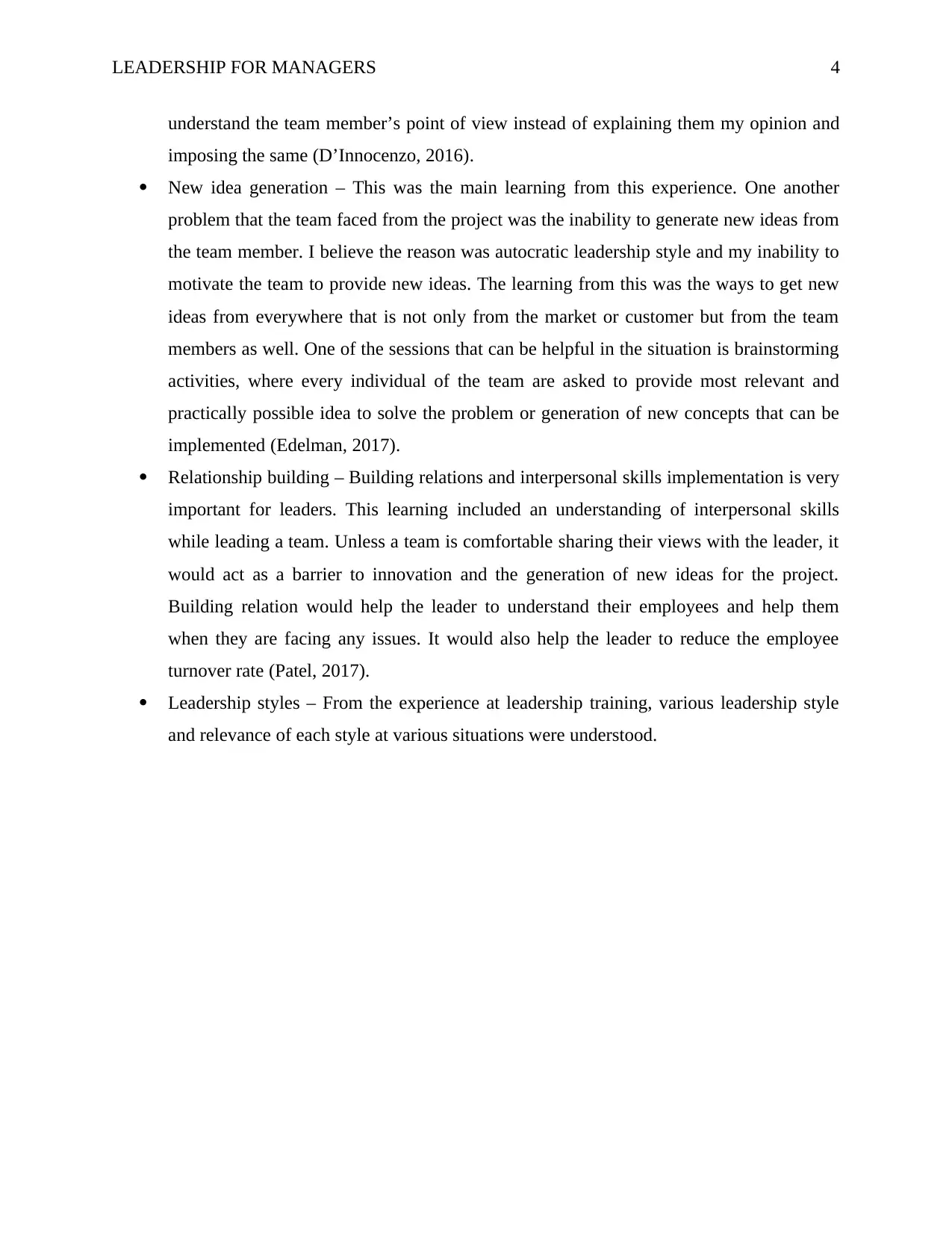
LEADERSHIP FOR MANAGERS 4
understand the team member’s point of view instead of explaining them my opinion and
imposing the same (D’Innocenzo, 2016).
New idea generation – This was the main learning from this experience. One another
problem that the team faced from the project was the inability to generate new ideas from
the team member. I believe the reason was autocratic leadership style and my inability to
motivate the team to provide new ideas. The learning from this was the ways to get new
ideas from everywhere that is not only from the market or customer but from the team
members as well. One of the sessions that can be helpful in the situation is brainstorming
activities, where every individual of the team are asked to provide most relevant and
practically possible idea to solve the problem or generation of new concepts that can be
implemented (Edelman, 2017).
Relationship building – Building relations and interpersonal skills implementation is very
important for leaders. This learning included an understanding of interpersonal skills
while leading a team. Unless a team is comfortable sharing their views with the leader, it
would act as a barrier to innovation and the generation of new ideas for the project.
Building relation would help the leader to understand their employees and help them
when they are facing any issues. It would also help the leader to reduce the employee
turnover rate (Patel, 2017).
Leadership styles – From the experience at leadership training, various leadership style
and relevance of each style at various situations were understood.
understand the team member’s point of view instead of explaining them my opinion and
imposing the same (D’Innocenzo, 2016).
New idea generation – This was the main learning from this experience. One another
problem that the team faced from the project was the inability to generate new ideas from
the team member. I believe the reason was autocratic leadership style and my inability to
motivate the team to provide new ideas. The learning from this was the ways to get new
ideas from everywhere that is not only from the market or customer but from the team
members as well. One of the sessions that can be helpful in the situation is brainstorming
activities, where every individual of the team are asked to provide most relevant and
practically possible idea to solve the problem or generation of new concepts that can be
implemented (Edelman, 2017).
Relationship building – Building relations and interpersonal skills implementation is very
important for leaders. This learning included an understanding of interpersonal skills
while leading a team. Unless a team is comfortable sharing their views with the leader, it
would act as a barrier to innovation and the generation of new ideas for the project.
Building relation would help the leader to understand their employees and help them
when they are facing any issues. It would also help the leader to reduce the employee
turnover rate (Patel, 2017).
Leadership styles – From the experience at leadership training, various leadership style
and relevance of each style at various situations were understood.
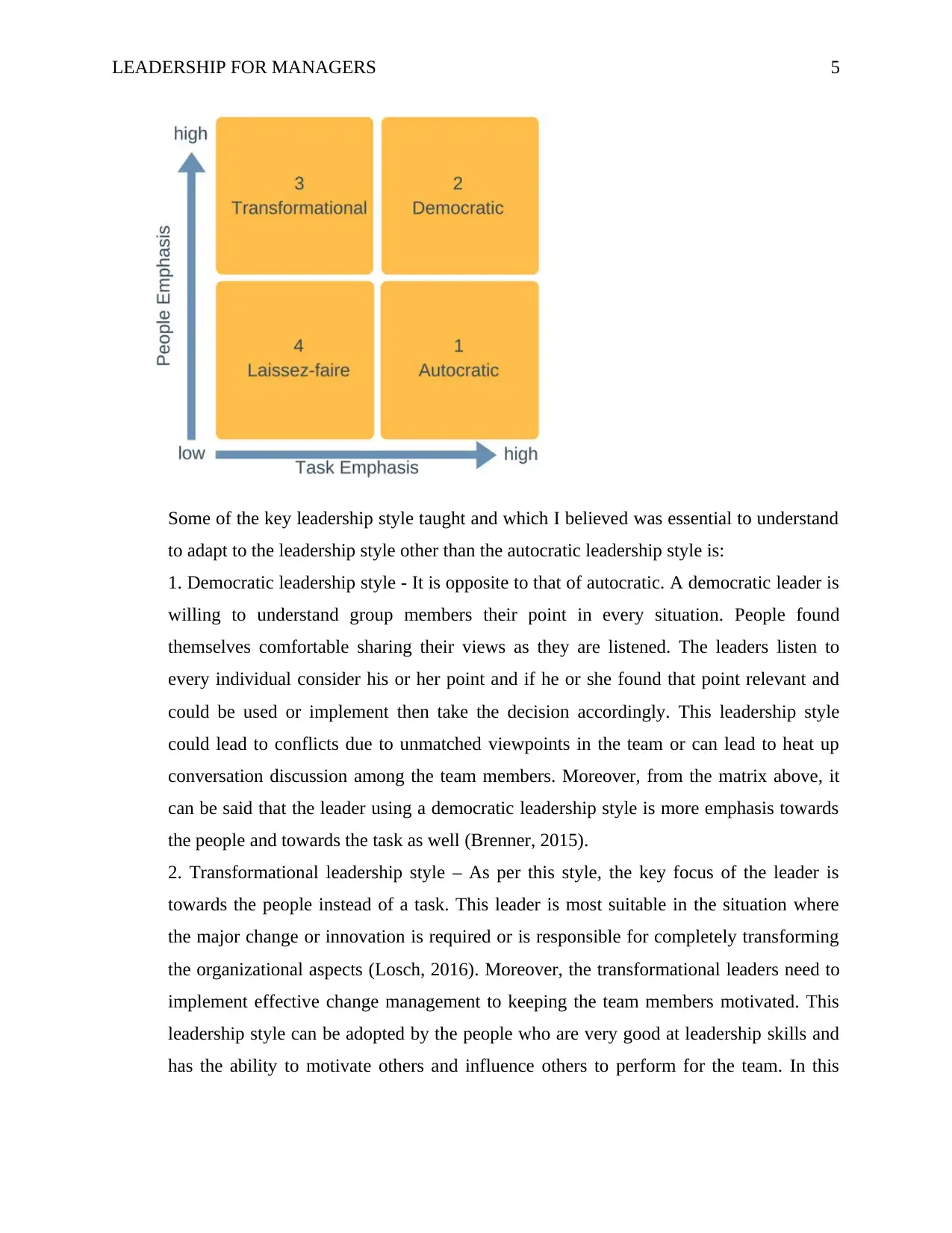
LEADERSHIP FOR MANAGERS 5
Some of the key leadership style taught and which I believed was essential to understand
to adapt to the leadership style other than the autocratic leadership style is:
1. Democratic leadership style - It is opposite to that of autocratic. A democratic leader is
willing to understand group members their point in every situation. People found
themselves comfortable sharing their views as they are listened. The leaders listen to
every individual consider his or her point and if he or she found that point relevant and
could be used or implement then take the decision accordingly. This leadership style
could lead to conflicts due to unmatched viewpoints in the team or can lead to heat up
conversation discussion among the team members. Moreover, from the matrix above, it
can be said that the leader using a democratic leadership style is more emphasis towards
the people and towards the task as well (Brenner, 2015).
2. Transformational leadership style – As per this style, the key focus of the leader is
towards the people instead of a task. This leader is most suitable in the situation where
the major change or innovation is required or is responsible for completely transforming
the organizational aspects (Losch, 2016). Moreover, the transformational leaders need to
implement effective change management to keeping the team members motivated. This
leadership style can be adopted by the people who are very good at leadership skills and
has the ability to motivate others and influence others to perform for the team. In this
Some of the key leadership style taught and which I believed was essential to understand
to adapt to the leadership style other than the autocratic leadership style is:
1. Democratic leadership style - It is opposite to that of autocratic. A democratic leader is
willing to understand group members their point in every situation. People found
themselves comfortable sharing their views as they are listened. The leaders listen to
every individual consider his or her point and if he or she found that point relevant and
could be used or implement then take the decision accordingly. This leadership style
could lead to conflicts due to unmatched viewpoints in the team or can lead to heat up
conversation discussion among the team members. Moreover, from the matrix above, it
can be said that the leader using a democratic leadership style is more emphasis towards
the people and towards the task as well (Brenner, 2015).
2. Transformational leadership style – As per this style, the key focus of the leader is
towards the people instead of a task. This leader is most suitable in the situation where
the major change or innovation is required or is responsible for completely transforming
the organizational aspects (Losch, 2016). Moreover, the transformational leaders need to
implement effective change management to keeping the team members motivated. This
leadership style can be adopted by the people who are very good at leadership skills and
has the ability to motivate others and influence others to perform for the team. In this
⊘ This is a preview!⊘
Do you want full access?
Subscribe today to unlock all pages.

Trusted by 1+ million students worldwide
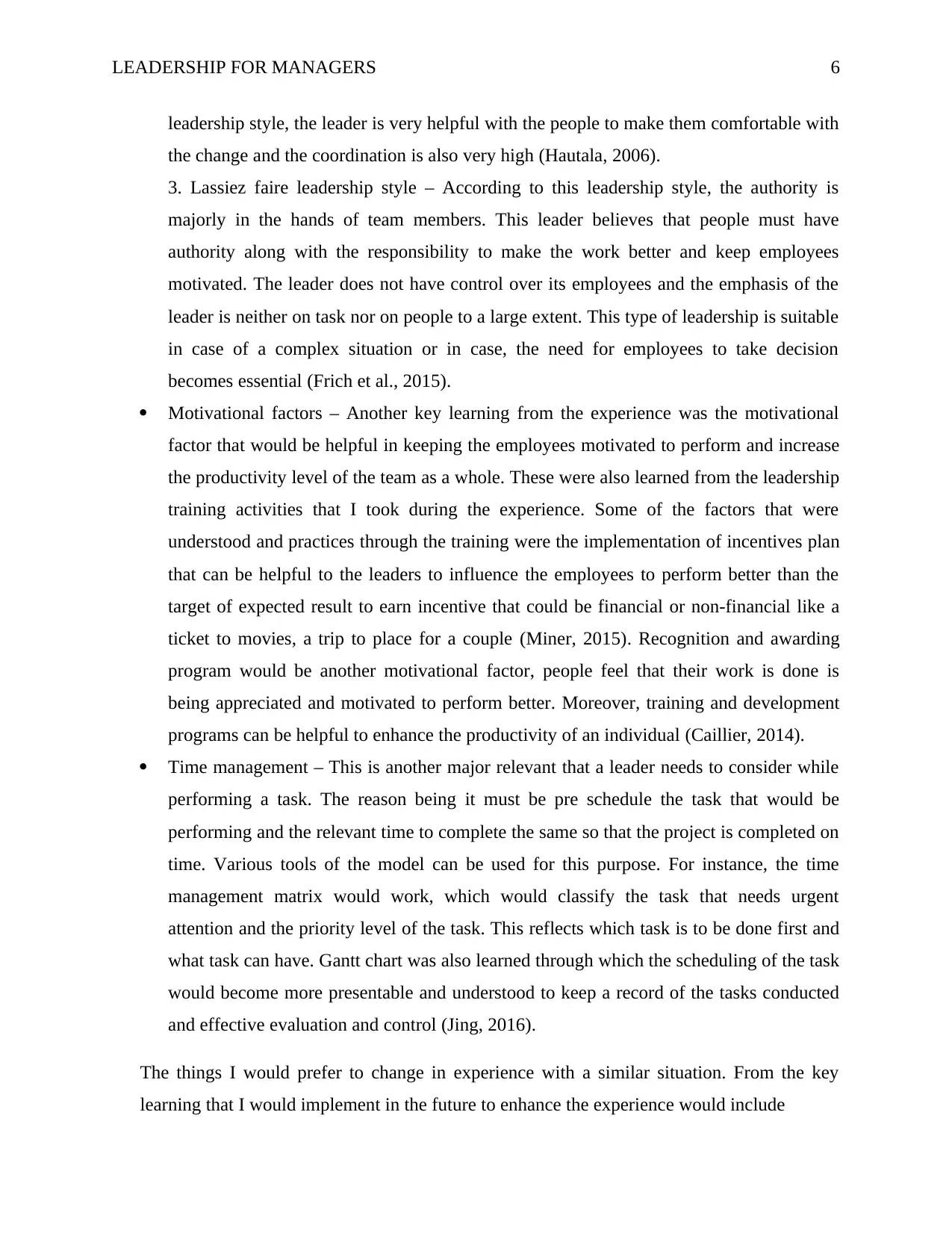
LEADERSHIP FOR MANAGERS 6
leadership style, the leader is very helpful with the people to make them comfortable with
the change and the coordination is also very high (Hautala, 2006).
3. Lassiez faire leadership style – According to this leadership style, the authority is
majorly in the hands of team members. This leader believes that people must have
authority along with the responsibility to make the work better and keep employees
motivated. The leader does not have control over its employees and the emphasis of the
leader is neither on task nor on people to a large extent. This type of leadership is suitable
in case of a complex situation or in case, the need for employees to take decision
becomes essential (Frich et al., 2015).
Motivational factors – Another key learning from the experience was the motivational
factor that would be helpful in keeping the employees motivated to perform and increase
the productivity level of the team as a whole. These were also learned from the leadership
training activities that I took during the experience. Some of the factors that were
understood and practices through the training were the implementation of incentives plan
that can be helpful to the leaders to influence the employees to perform better than the
target of expected result to earn incentive that could be financial or non-financial like a
ticket to movies, a trip to place for a couple (Miner, 2015). Recognition and awarding
program would be another motivational factor, people feel that their work is done is
being appreciated and motivated to perform better. Moreover, training and development
programs can be helpful to enhance the productivity of an individual (Caillier, 2014).
Time management – This is another major relevant that a leader needs to consider while
performing a task. The reason being it must be pre schedule the task that would be
performing and the relevant time to complete the same so that the project is completed on
time. Various tools of the model can be used for this purpose. For instance, the time
management matrix would work, which would classify the task that needs urgent
attention and the priority level of the task. This reflects which task is to be done first and
what task can have. Gantt chart was also learned through which the scheduling of the task
would become more presentable and understood to keep a record of the tasks conducted
and effective evaluation and control (Jing, 2016).
The things I would prefer to change in experience with a similar situation. From the key
learning that I would implement in the future to enhance the experience would include
leadership style, the leader is very helpful with the people to make them comfortable with
the change and the coordination is also very high (Hautala, 2006).
3. Lassiez faire leadership style – According to this leadership style, the authority is
majorly in the hands of team members. This leader believes that people must have
authority along with the responsibility to make the work better and keep employees
motivated. The leader does not have control over its employees and the emphasis of the
leader is neither on task nor on people to a large extent. This type of leadership is suitable
in case of a complex situation or in case, the need for employees to take decision
becomes essential (Frich et al., 2015).
Motivational factors – Another key learning from the experience was the motivational
factor that would be helpful in keeping the employees motivated to perform and increase
the productivity level of the team as a whole. These were also learned from the leadership
training activities that I took during the experience. Some of the factors that were
understood and practices through the training were the implementation of incentives plan
that can be helpful to the leaders to influence the employees to perform better than the
target of expected result to earn incentive that could be financial or non-financial like a
ticket to movies, a trip to place for a couple (Miner, 2015). Recognition and awarding
program would be another motivational factor, people feel that their work is done is
being appreciated and motivated to perform better. Moreover, training and development
programs can be helpful to enhance the productivity of an individual (Caillier, 2014).
Time management – This is another major relevant that a leader needs to consider while
performing a task. The reason being it must be pre schedule the task that would be
performing and the relevant time to complete the same so that the project is completed on
time. Various tools of the model can be used for this purpose. For instance, the time
management matrix would work, which would classify the task that needs urgent
attention and the priority level of the task. This reflects which task is to be done first and
what task can have. Gantt chart was also learned through which the scheduling of the task
would become more presentable and understood to keep a record of the tasks conducted
and effective evaluation and control (Jing, 2016).
The things I would prefer to change in experience with a similar situation. From the key
learning that I would implement in the future to enhance the experience would include
Paraphrase This Document
Need a fresh take? Get an instant paraphrase of this document with our AI Paraphraser
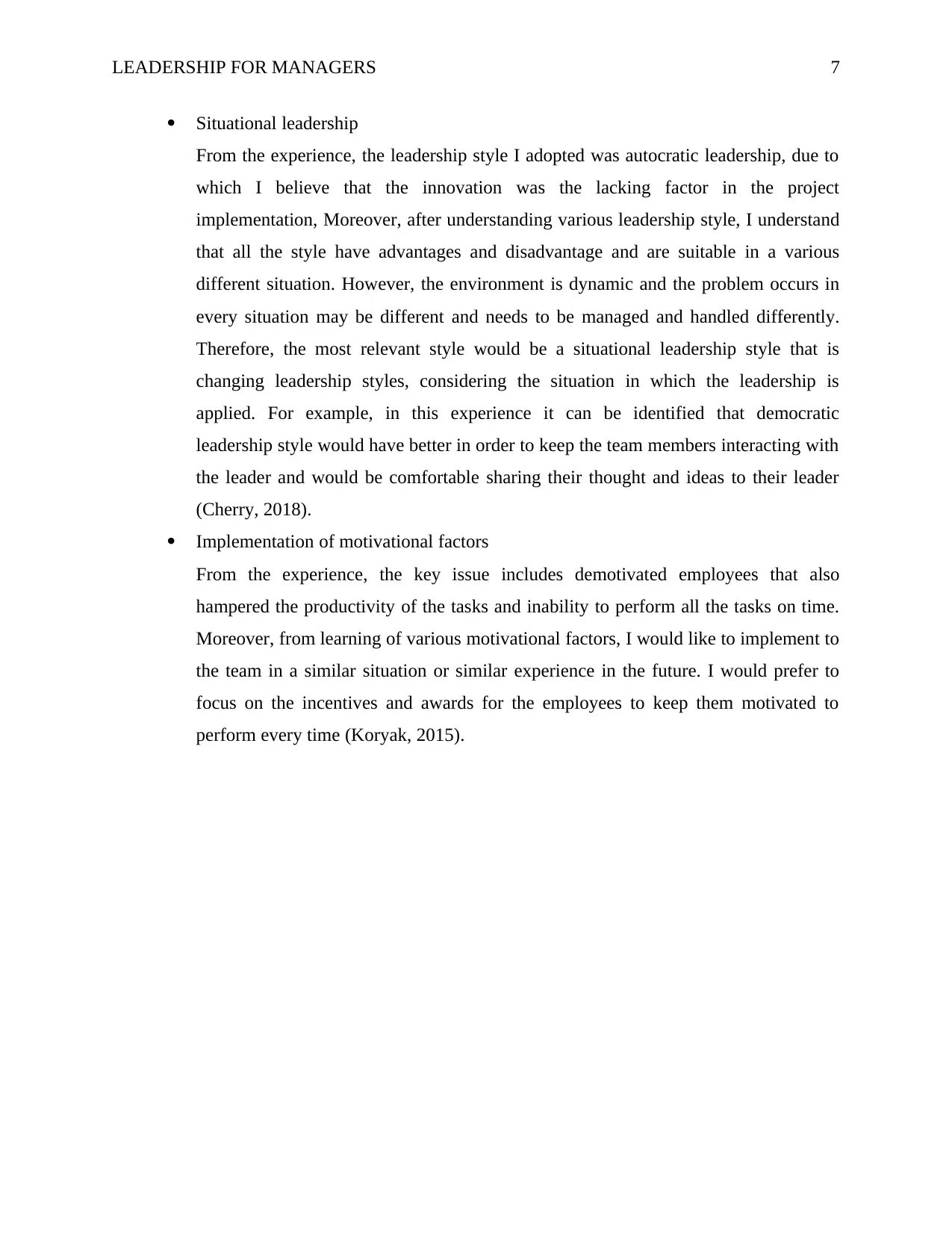
LEADERSHIP FOR MANAGERS 7
Situational leadership
From the experience, the leadership style I adopted was autocratic leadership, due to
which I believe that the innovation was the lacking factor in the project
implementation, Moreover, after understanding various leadership style, I understand
that all the style have advantages and disadvantage and are suitable in a various
different situation. However, the environment is dynamic and the problem occurs in
every situation may be different and needs to be managed and handled differently.
Therefore, the most relevant style would be a situational leadership style that is
changing leadership styles, considering the situation in which the leadership is
applied. For example, in this experience it can be identified that democratic
leadership style would have better in order to keep the team members interacting with
the leader and would be comfortable sharing their thought and ideas to their leader
(Cherry, 2018).
Implementation of motivational factors
From the experience, the key issue includes demotivated employees that also
hampered the productivity of the tasks and inability to perform all the tasks on time.
Moreover, from learning of various motivational factors, I would like to implement to
the team in a similar situation or similar experience in the future. I would prefer to
focus on the incentives and awards for the employees to keep them motivated to
perform every time (Koryak, 2015).
Situational leadership
From the experience, the leadership style I adopted was autocratic leadership, due to
which I believe that the innovation was the lacking factor in the project
implementation, Moreover, after understanding various leadership style, I understand
that all the style have advantages and disadvantage and are suitable in a various
different situation. However, the environment is dynamic and the problem occurs in
every situation may be different and needs to be managed and handled differently.
Therefore, the most relevant style would be a situational leadership style that is
changing leadership styles, considering the situation in which the leadership is
applied. For example, in this experience it can be identified that democratic
leadership style would have better in order to keep the team members interacting with
the leader and would be comfortable sharing their thought and ideas to their leader
(Cherry, 2018).
Implementation of motivational factors
From the experience, the key issue includes demotivated employees that also
hampered the productivity of the tasks and inability to perform all the tasks on time.
Moreover, from learning of various motivational factors, I would like to implement to
the team in a similar situation or similar experience in the future. I would prefer to
focus on the incentives and awards for the employees to keep them motivated to
perform every time (Koryak, 2015).
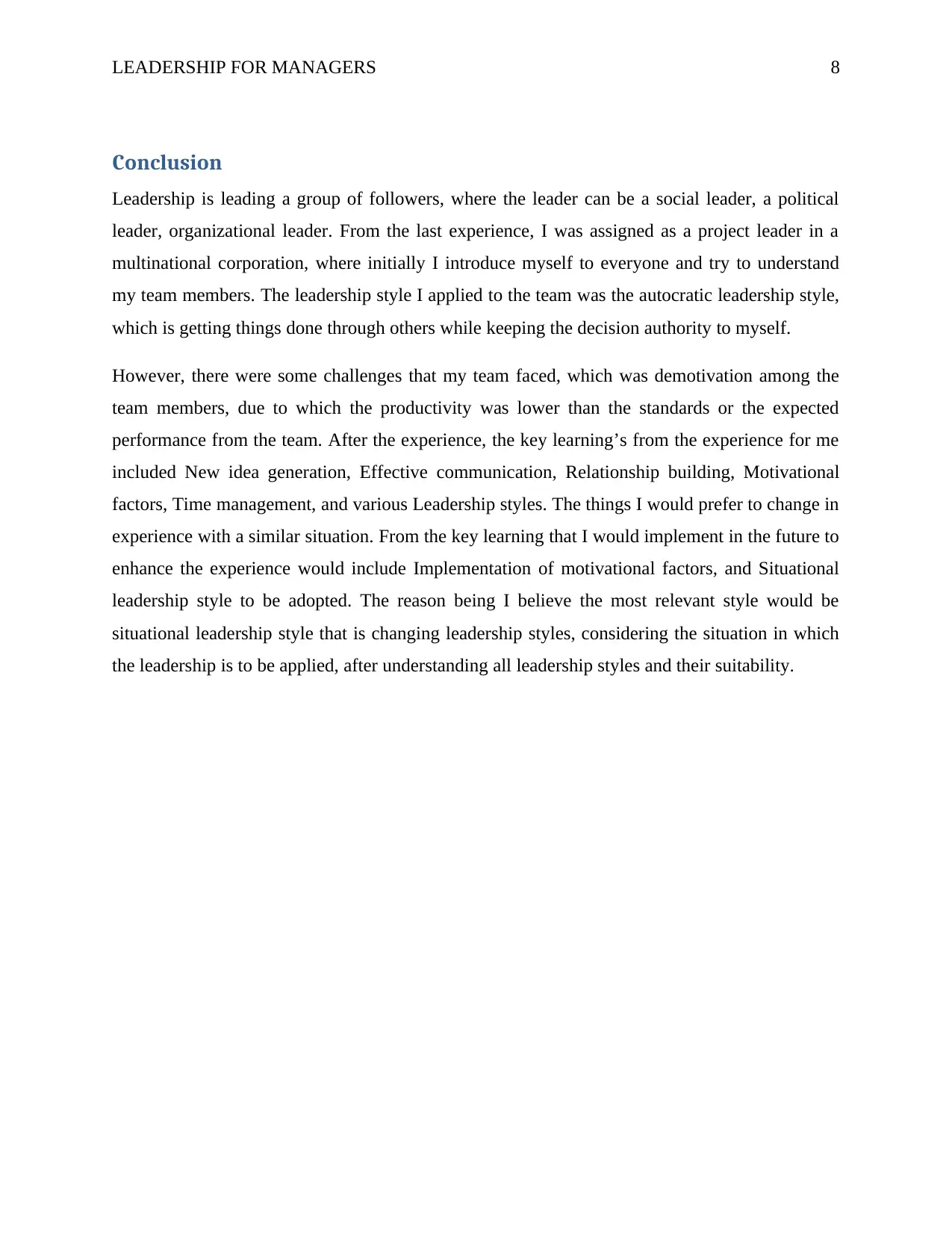
LEADERSHIP FOR MANAGERS 8
Conclusion
Leadership is leading a group of followers, where the leader can be a social leader, a political
leader, organizational leader. From the last experience, I was assigned as a project leader in a
multinational corporation, where initially I introduce myself to everyone and try to understand
my team members. The leadership style I applied to the team was the autocratic leadership style,
which is getting things done through others while keeping the decision authority to myself.
However, there were some challenges that my team faced, which was demotivation among the
team members, due to which the productivity was lower than the standards or the expected
performance from the team. After the experience, the key learning’s from the experience for me
included New idea generation, Effective communication, Relationship building, Motivational
factors, Time management, and various Leadership styles. The things I would prefer to change in
experience with a similar situation. From the key learning that I would implement in the future to
enhance the experience would include Implementation of motivational factors, and Situational
leadership style to be adopted. The reason being I believe the most relevant style would be
situational leadership style that is changing leadership styles, considering the situation in which
the leadership is to be applied, after understanding all leadership styles and their suitability.
Conclusion
Leadership is leading a group of followers, where the leader can be a social leader, a political
leader, organizational leader. From the last experience, I was assigned as a project leader in a
multinational corporation, where initially I introduce myself to everyone and try to understand
my team members. The leadership style I applied to the team was the autocratic leadership style,
which is getting things done through others while keeping the decision authority to myself.
However, there were some challenges that my team faced, which was demotivation among the
team members, due to which the productivity was lower than the standards or the expected
performance from the team. After the experience, the key learning’s from the experience for me
included New idea generation, Effective communication, Relationship building, Motivational
factors, Time management, and various Leadership styles. The things I would prefer to change in
experience with a similar situation. From the key learning that I would implement in the future to
enhance the experience would include Implementation of motivational factors, and Situational
leadership style to be adopted. The reason being I believe the most relevant style would be
situational leadership style that is changing leadership styles, considering the situation in which
the leadership is to be applied, after understanding all leadership styles and their suitability.
⊘ This is a preview!⊘
Do you want full access?
Subscribe today to unlock all pages.

Trusted by 1+ million students worldwide
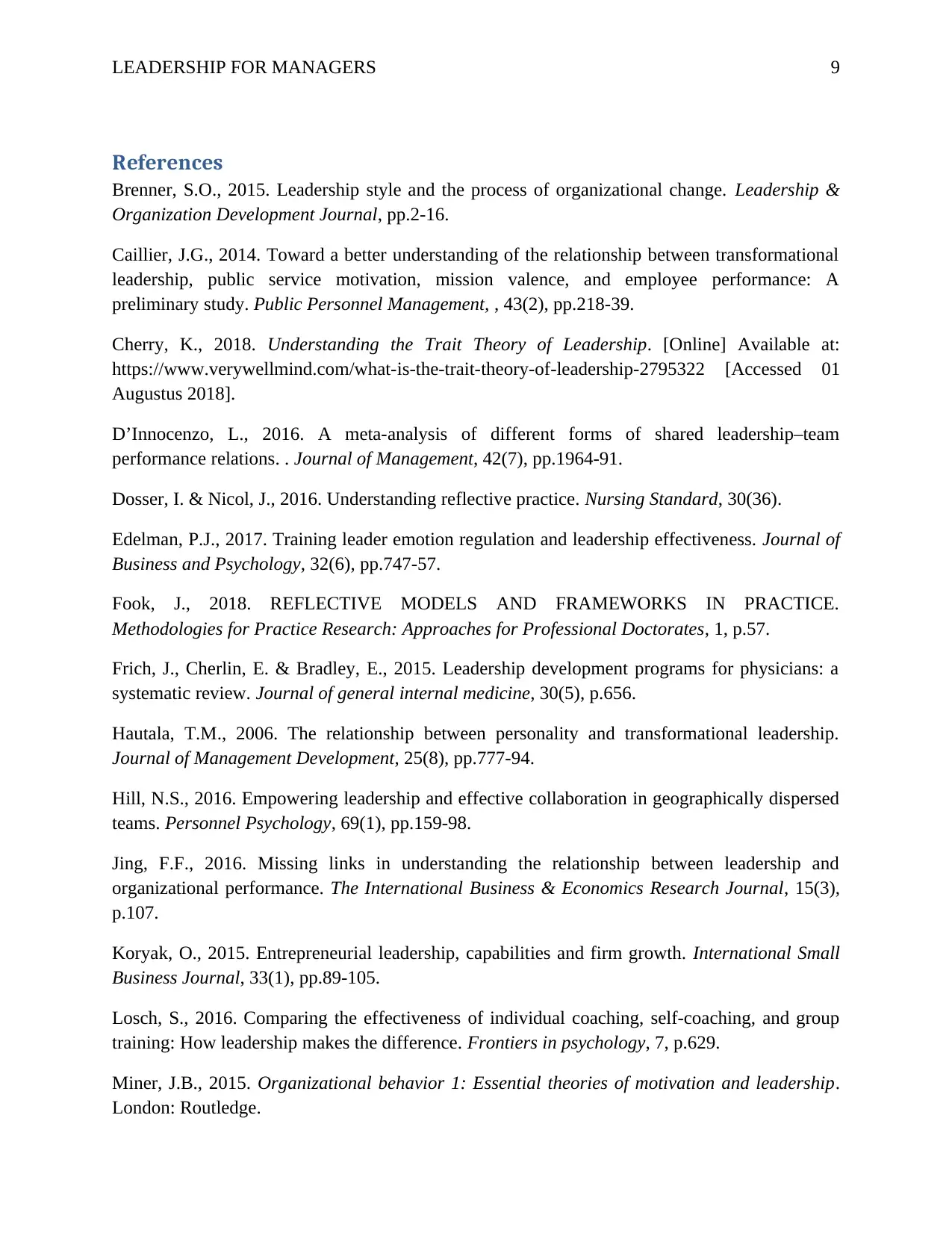
LEADERSHIP FOR MANAGERS 9
References
Brenner, S.O., 2015. Leadership style and the process of organizational change. Leadership &
Organization Development Journal, pp.2-16.
Caillier, J.G., 2014. Toward a better understanding of the relationship between transformational
leadership, public service motivation, mission valence, and employee performance: A
preliminary study. Public Personnel Management, , 43(2), pp.218-39.
Cherry, K., 2018. Understanding the Trait Theory of Leadership. [Online] Available at:
https://www.verywellmind.com/what-is-the-trait-theory-of-leadership-2795322 [Accessed 01
Augustus 2018].
D’Innocenzo, L., 2016. A meta-analysis of different forms of shared leadership–team
performance relations. . Journal of Management, 42(7), pp.1964-91.
Dosser, I. & Nicol, J., 2016. Understanding reflective practice. Nursing Standard, 30(36).
Edelman, P.J., 2017. Training leader emotion regulation and leadership effectiveness. Journal of
Business and Psychology, 32(6), pp.747-57.
Fook, J., 2018. REFLECTIVE MODELS AND FRAMEWORKS IN PRACTICE.
Methodologies for Practice Research: Approaches for Professional Doctorates, 1, p.57.
Frich, J., Cherlin, E. & Bradley, E., 2015. Leadership development programs for physicians: a
systematic review. Journal of general internal medicine, 30(5), p.656.
Hautala, T.M., 2006. The relationship between personality and transformational leadership.
Journal of Management Development, 25(8), pp.777-94.
Hill, N.S., 2016. Empowering leadership and effective collaboration in geographically dispersed
teams. Personnel Psychology, 69(1), pp.159-98.
Jing, F.F., 2016. Missing links in understanding the relationship between leadership and
organizational performance. The International Business & Economics Research Journal, 15(3),
p.107.
Koryak, O., 2015. Entrepreneurial leadership, capabilities and firm growth. International Small
Business Journal, 33(1), pp.89-105.
Losch, S., 2016. Comparing the effectiveness of individual coaching, self-coaching, and group
training: How leadership makes the difference. Frontiers in psychology, 7, p.629.
Miner, J.B., 2015. Organizational behavior 1: Essential theories of motivation and leadership.
London: Routledge.
References
Brenner, S.O., 2015. Leadership style and the process of organizational change. Leadership &
Organization Development Journal, pp.2-16.
Caillier, J.G., 2014. Toward a better understanding of the relationship between transformational
leadership, public service motivation, mission valence, and employee performance: A
preliminary study. Public Personnel Management, , 43(2), pp.218-39.
Cherry, K., 2018. Understanding the Trait Theory of Leadership. [Online] Available at:
https://www.verywellmind.com/what-is-the-trait-theory-of-leadership-2795322 [Accessed 01
Augustus 2018].
D’Innocenzo, L., 2016. A meta-analysis of different forms of shared leadership–team
performance relations. . Journal of Management, 42(7), pp.1964-91.
Dosser, I. & Nicol, J., 2016. Understanding reflective practice. Nursing Standard, 30(36).
Edelman, P.J., 2017. Training leader emotion regulation and leadership effectiveness. Journal of
Business and Psychology, 32(6), pp.747-57.
Fook, J., 2018. REFLECTIVE MODELS AND FRAMEWORKS IN PRACTICE.
Methodologies for Practice Research: Approaches for Professional Doctorates, 1, p.57.
Frich, J., Cherlin, E. & Bradley, E., 2015. Leadership development programs for physicians: a
systematic review. Journal of general internal medicine, 30(5), p.656.
Hautala, T.M., 2006. The relationship between personality and transformational leadership.
Journal of Management Development, 25(8), pp.777-94.
Hill, N.S., 2016. Empowering leadership and effective collaboration in geographically dispersed
teams. Personnel Psychology, 69(1), pp.159-98.
Jing, F.F., 2016. Missing links in understanding the relationship between leadership and
organizational performance. The International Business & Economics Research Journal, 15(3),
p.107.
Koryak, O., 2015. Entrepreneurial leadership, capabilities and firm growth. International Small
Business Journal, 33(1), pp.89-105.
Losch, S., 2016. Comparing the effectiveness of individual coaching, self-coaching, and group
training: How leadership makes the difference. Frontiers in psychology, 7, p.629.
Miner, J.B., 2015. Organizational behavior 1: Essential theories of motivation and leadership.
London: Routledge.
Paraphrase This Document
Need a fresh take? Get an instant paraphrase of this document with our AI Paraphraser
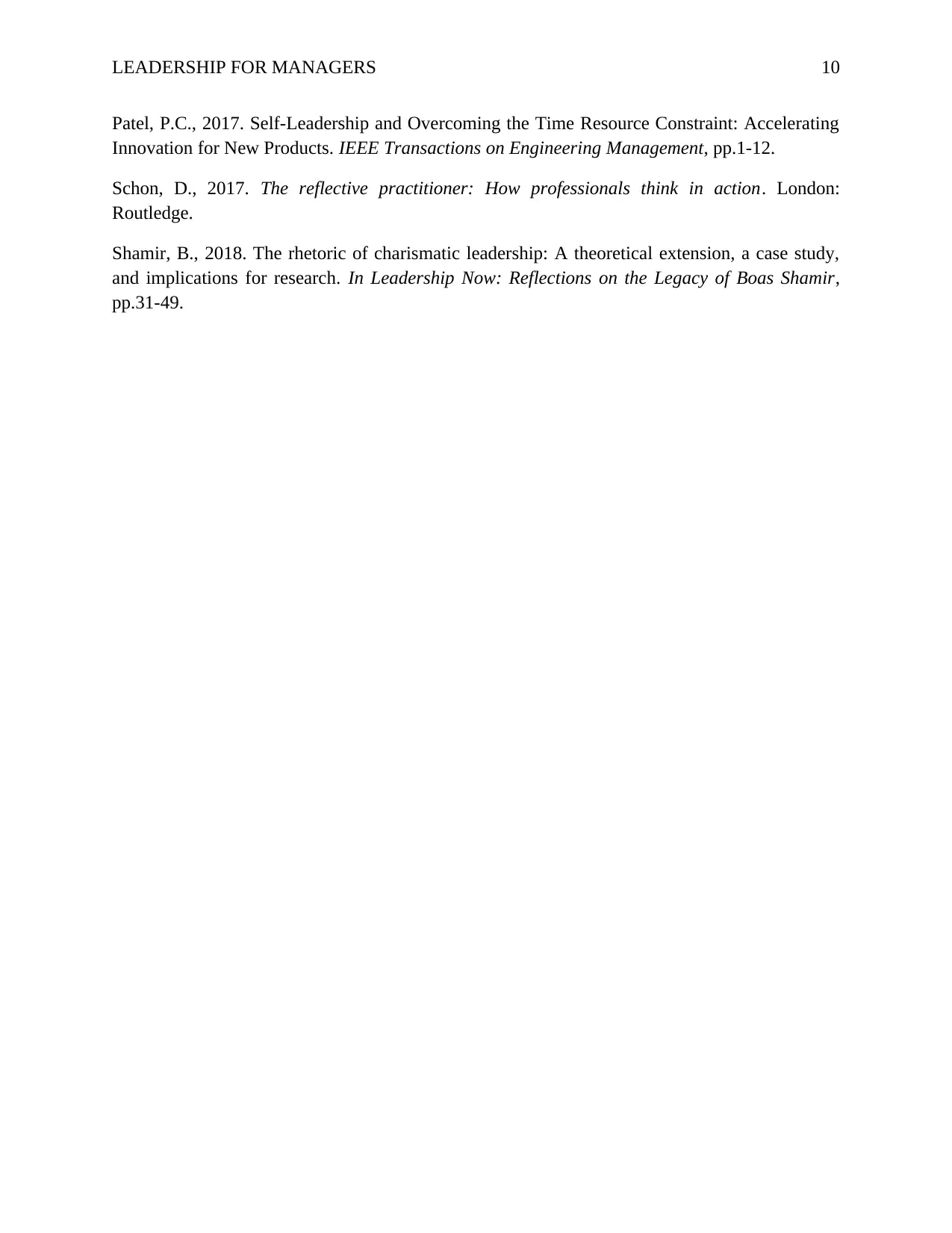
LEADERSHIP FOR MANAGERS 10
Patel, P.C., 2017. Self-Leadership and Overcoming the Time Resource Constraint: Accelerating
Innovation for New Products. IEEE Transactions on Engineering Management, pp.1-12.
Schon, D., 2017. The reflective practitioner: How professionals think in action. London:
Routledge.
Shamir, B., 2018. The rhetoric of charismatic leadership: A theoretical extension, a case study,
and implications for research. In Leadership Now: Reflections on the Legacy of Boas Shamir,
pp.31-49.
Patel, P.C., 2017. Self-Leadership and Overcoming the Time Resource Constraint: Accelerating
Innovation for New Products. IEEE Transactions on Engineering Management, pp.1-12.
Schon, D., 2017. The reflective practitioner: How professionals think in action. London:
Routledge.
Shamir, B., 2018. The rhetoric of charismatic leadership: A theoretical extension, a case study,
and implications for research. In Leadership Now: Reflections on the Legacy of Boas Shamir,
pp.31-49.
1 out of 11
Related Documents
Your All-in-One AI-Powered Toolkit for Academic Success.
+13062052269
info@desklib.com
Available 24*7 on WhatsApp / Email
![[object Object]](/_next/static/media/star-bottom.7253800d.svg)
Unlock your academic potential
Copyright © 2020–2025 A2Z Services. All Rights Reserved. Developed and managed by ZUCOL.





